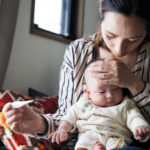Providing a safe and nurturing environment is essential for a newborn’s physical, emotional, and developmental well-being. During the neonatal period, babies are entirely dependent on their caregivers for protection, comfort, and stimulation. A secure and supportive home environment fosters healthy growth, strengthens the parent-child bond, and lays the foundation for lifelong emotional resilience. By focusing on safety, routine, and love, parents can ensure their baby thrives in this critical stage of development.

1. Physical Safety in the Home
1.1. Safe Sleep Practices
- Position: Always place the baby on their back to sleep to reduce the risk of Sudden Infant Death Syndrome (SIDS).
- Sleep Surface: Use a firm mattress in a crib with no loose bedding, pillows, or stuffed animals.
- Room Sharing: Keep the baby’s crib in the parents’ room for the first 6–12 months.
1.2. Feeding Safety
- Breastfeeding: Ensure the baby is properly latched to prevent choking or discomfort.
- Bottle Feeding: Sterilize bottles and use the correct formula-to-water ratio to avoid dehydration or malnutrition.
1.3. General Safety Measures
- Temperature: Maintain a comfortable room temperature (around 68–72°F or 20–22°C) to avoid overheating.
- Bathing: Never leave the baby unattended during bath time and ensure the water is lukewarm.
- Car Seats: Use an approved rear-facing car seat, properly installed according to safety guidelines.
2. Emotional and Social Nurturing
2.1. Bonding with the Baby
- Skin-to-Skin Contact: Promotes bonding, regulates the baby’s temperature, and soothes stress for both parent and child.
- Responsive Care: Attend to the baby’s cries promptly to build trust and a sense of security.
2.2. Establishing Routines
- Create a predictable daily routine for feeding, sleeping, and playtime. This helps the baby feel safe and promotes healthy habits.
2.3. Providing Comfort
- Use gentle rocking, soothing sounds, or cuddling to calm the baby.
- Ensure the baby has ample opportunities to be held and comforted, especially during fussy periods.
3. Stimulating Development
3.1. Sensory Stimulation
- Offer age-appropriate toys with high-contrast patterns or soft sounds.
- Talk, sing, and read to the baby to encourage language development and social engagement.
3.2. Encouraging Tummy Time
- Supervised tummy time strengthens the baby’s neck, shoulder, and core muscles.
3.3. Interaction with Caregivers
- Maintain eye contact, smile, and engage in face-to-face interaction to support emotional development.
4. Building a Supportive Environment for Parents
4.1. Involving Family and Friends
- Ask for help with household tasks or caregiving to reduce parental stress.
- Surround yourself with a positive support system that fosters encouragement and understanding.
4.2. Managing Parental Stress
- Practice self-care and take breaks when needed.
- Attend parenting classes or support groups to build confidence and skills.
5. Recognizing and Adapting to the Baby’s Needs
5.1. Understanding Cues
- Learn to recognize hunger, sleepiness, and discomfort signals.
- Adapt responses based on the baby’s needs to foster emotional security.
5.2. Maintaining Flexibility
- Be prepared to adjust routines as the baby grows and their needs change.
6. Long-Term Benefits of a Safe and Nurturing Environment
- Physical Growth: A safe environment reduces risks of injury or illness.
- Emotional Security: Consistent care helps babies develop trust and resilience.
- Cognitive Development: Stimulation and interaction encourage early learning and problem-solving skills.
Conclusion
Creating a safe and nurturing environment for a newborn is a cornerstone of effective parenting. By prioritizing safety, emotional connection, and developmental stimulation, parents can help their baby thrive during the critical neonatal period. A balanced approach to caregiving not only fosters the baby’s growth but also strengthens the parent-child bond, ensuring a strong foundation for the future. With love, patience, and support, caregivers can provide their newborns with the best possible start in life.
you might want to read…







